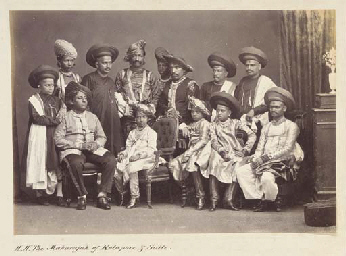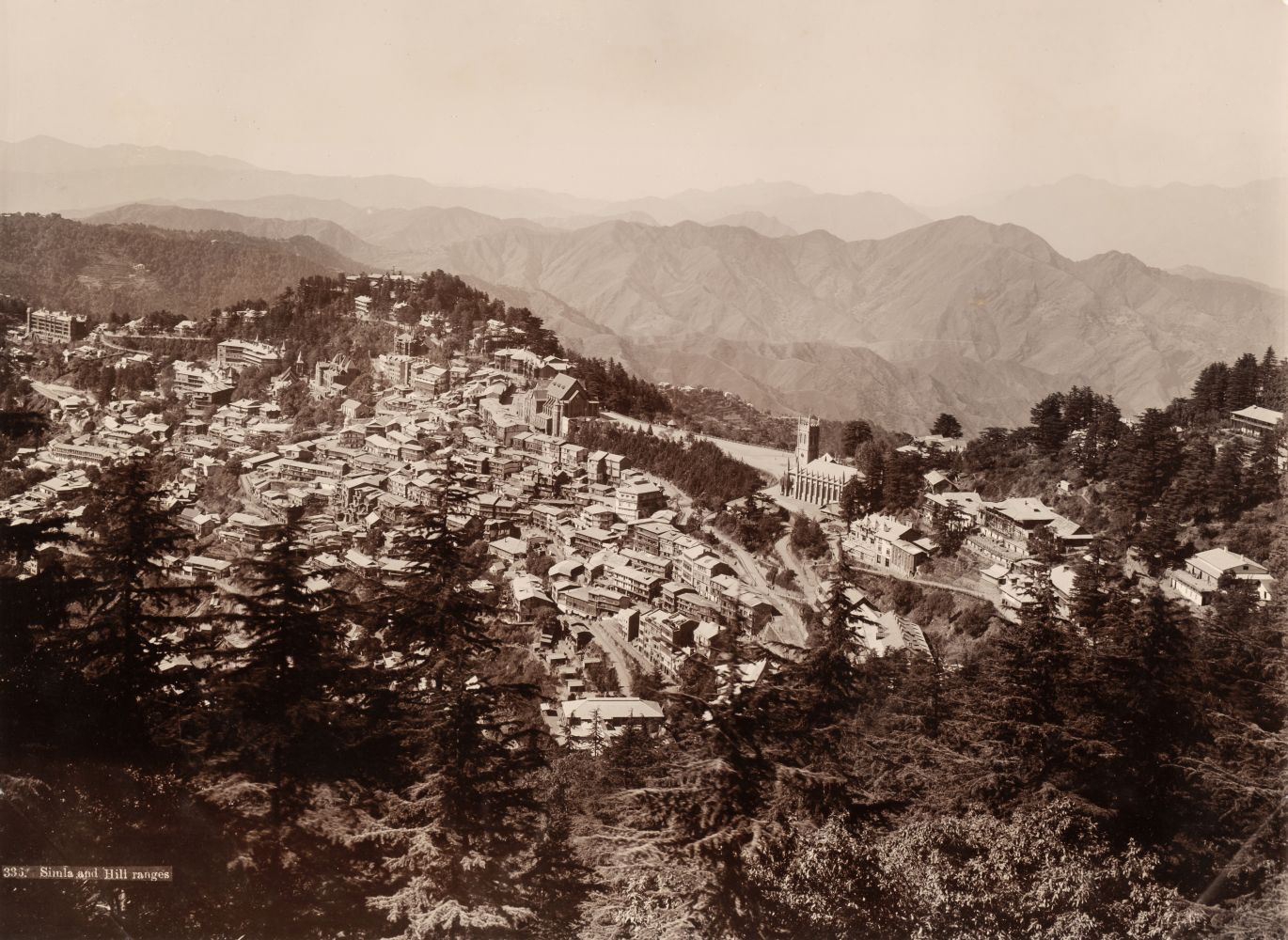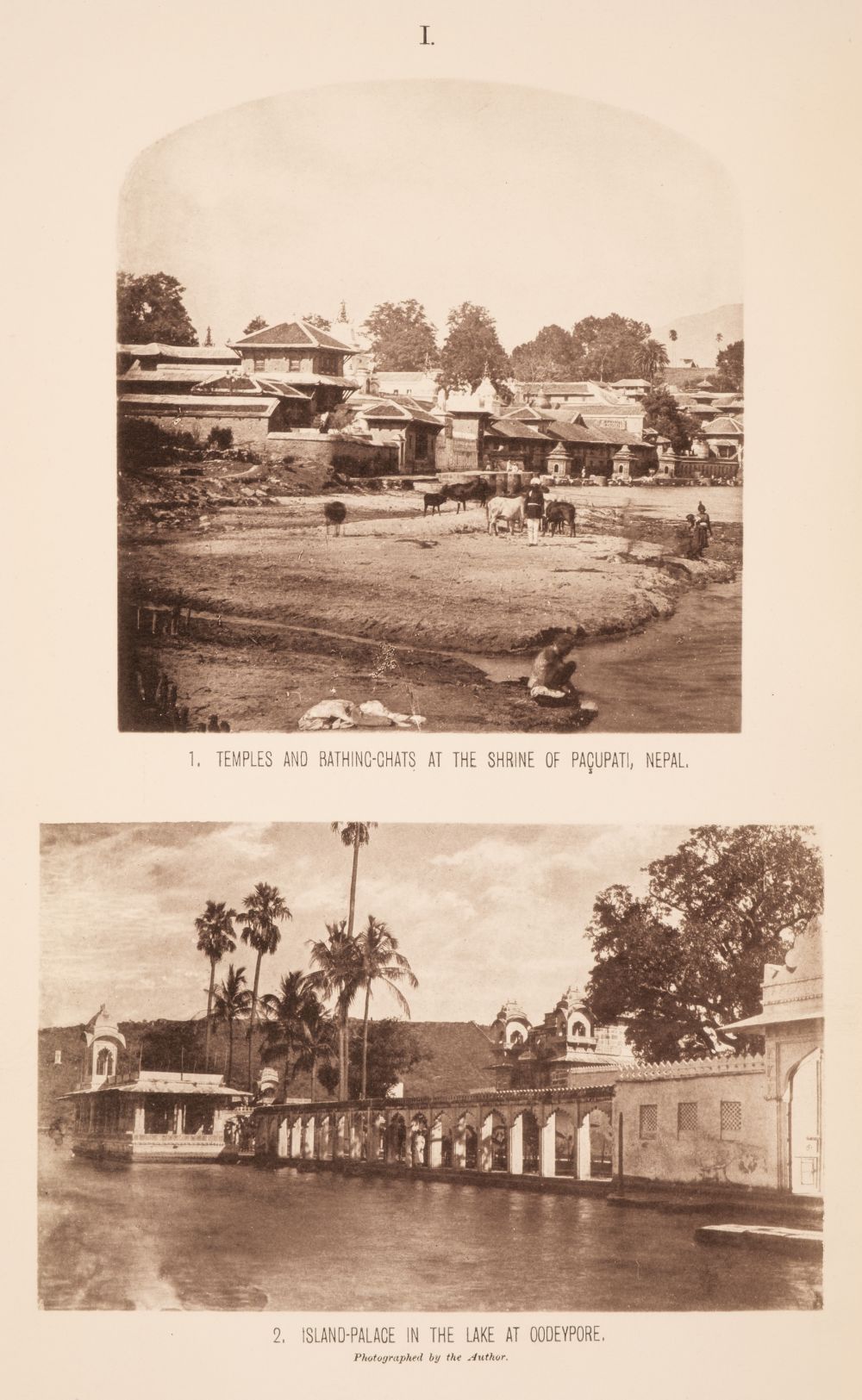Northern India and the second Sikh War. Mrs CAMPBELL. A fair-copy manuscript journal, 'Recollections of India from 1849 to 1854', n.d. [1854 or shortly afterwards (some leaves watermarked 1854-1855)], illustrated with 58 original drawings in watercolour or pencil (including 30 AGRA SCHOOL AND 4 DELHI SCHOOL watercolours) and one photograph, 134 leaves, folio (405 x 300mm), contemporary maroon morocco gilt, covers with wide decorative border of roll tools and fillets, spine in six compartments with raised bands, with repeat decorative tooling within triple fillet borders, gilt metal clasp, gilt edges. Mrs. Campbell, the wife of James Campbell (a senior officer in the 87th Prince of Wales Irish Fusiliers), gives a vivid account of a tour of duty in northern India during a lull in a turbulent period in the sub-continent's history: the second Sikh war was concluded shortly before their arrival and the Indian mutiny was to break out three years after they sailed for home. The illustrations include 30 Agra school drawings (most 130 x 80mm. approx.) of the Taj Mahal, details of its interior and views and details of other buildings in the vicinity. The four Delhi school drawings, of similar size, are of the Red Fort. Mrs Campbell and her husband sailed from Gravesend to Madras aboard the Plantagenet (a pencil sketch of the ship and a pen and ink map of the route front the journal); leaving on 12 April 1849, they arrived on 22 July. They made their way east to west across the north of India and present-day Pakistan: from Madras to Calcutta, north to the Ganges, then west to Patna, Varanasi, Allahabad, Lucknow, Agra, Delhi, Simla, Ferozepore, Lahore, Amritsar, Rawalpindi, Bahawalpur, Sukkur, Hyderabad, Karachi. They set sail on 27 January 1854 from Bombay, travelling aboard the steamer Victoria via the Red Sea to Suez, overland to Alexandria and then home aboard the Indus , arriving on 6 March 1854. The journal is a fair copy with edited highlights only, but nevertheless gives an intimate picture of army life in India at the time. Mrs Campbell, who emerges as tough and resourceful and a shrewd judge of character, describes both the everyday and the extraordinary (but always with the breathtaking assumption of superiority not untypical of the European viewpoint of the period): of their visit to Agra she writes: 'A day of enchantment. At eleven Mr Lloyd & Mr Thomas came to drive us to the town and fort. No words can give an adequate description of this lovely building. It far surpassed anything I ever saw or even dreamt of. It is built of the purest white marble, each stone inlaid with black. The joining of the slabs of which the exterior is composed, is so close & compact, that not a fibre of vegetation is to be seen escaping from between them, nor does the rain or atmosphere have any effect in staining its polished surface. The whiteness is perfectly dazzling. It was built [by] Shah Jehan, the "King of the World" for his beautiful wife...the "Light of the World." Everything is beautifully finished. There is a broad border round the entrance of Persian characters, verses of the Koran carved in black marble on the white ground. The arches of the doors are neither Saxon nor Gothic, but allow of greater breadth than either, & are equally strong. It is generally supposed to have been built by Italians[!]...'
Northern India and the second Sikh War. Mrs CAMPBELL. A fair-copy manuscript journal, 'Recollections of India from 1849 to 1854', n.d. [1854 or shortly afterwards (some leaves watermarked 1854-1855)], illustrated with 58 original drawings in watercolour or pencil (including 30 AGRA SCHOOL AND 4 DELHI SCHOOL watercolours) and one photograph, 134 leaves, folio (405 x 300mm), contemporary maroon morocco gilt, covers with wide decorative border of roll tools and fillets, spine in six compartments with raised bands, with repeat decorative tooling within triple fillet borders, gilt metal clasp, gilt edges. Mrs. Campbell, the wife of James Campbell (a senior officer in the 87th Prince of Wales Irish Fusiliers), gives a vivid account of a tour of duty in northern India during a lull in a turbulent period in the sub-continent's history: the second Sikh war was concluded shortly before their arrival and the Indian mutiny was to break out three years after they sailed for home. The illustrations include 30 Agra school drawings (most 130 x 80mm. approx.) of the Taj Mahal, details of its interior and views and details of other buildings in the vicinity. The four Delhi school drawings, of similar size, are of the Red Fort. Mrs Campbell and her husband sailed from Gravesend to Madras aboard the Plantagenet (a pencil sketch of the ship and a pen and ink map of the route front the journal); leaving on 12 April 1849, they arrived on 22 July. They made their way east to west across the north of India and present-day Pakistan: from Madras to Calcutta, north to the Ganges, then west to Patna, Varanasi, Allahabad, Lucknow, Agra, Delhi, Simla, Ferozepore, Lahore, Amritsar, Rawalpindi, Bahawalpur, Sukkur, Hyderabad, Karachi. They set sail on 27 January 1854 from Bombay, travelling aboard the steamer Victoria via the Red Sea to Suez, overland to Alexandria and then home aboard the Indus , arriving on 6 March 1854. The journal is a fair copy with edited highlights only, but nevertheless gives an intimate picture of army life in India at the time. Mrs Campbell, who emerges as tough and resourceful and a shrewd judge of character, describes both the everyday and the extraordinary (but always with the breathtaking assumption of superiority not untypical of the European viewpoint of the period): of their visit to Agra she writes: 'A day of enchantment. At eleven Mr Lloyd & Mr Thomas came to drive us to the town and fort. No words can give an adequate description of this lovely building. It far surpassed anything I ever saw or even dreamt of. It is built of the purest white marble, each stone inlaid with black. The joining of the slabs of which the exterior is composed, is so close & compact, that not a fibre of vegetation is to be seen escaping from between them, nor does the rain or atmosphere have any effect in staining its polished surface. The whiteness is perfectly dazzling. It was built [by] Shah Jehan, the "King of the World" for his beautiful wife...the "Light of the World." Everything is beautifully finished. There is a broad border round the entrance of Persian characters, verses of the Koran carved in black marble on the white ground. The arches of the doors are neither Saxon nor Gothic, but allow of greater breadth than either, & are equally strong. It is generally supposed to have been built by Italians[!]...'














Try LotSearch and its premium features for 7 days - without any costs!
Be notified automatically about new items in upcoming auctions.
Create an alert